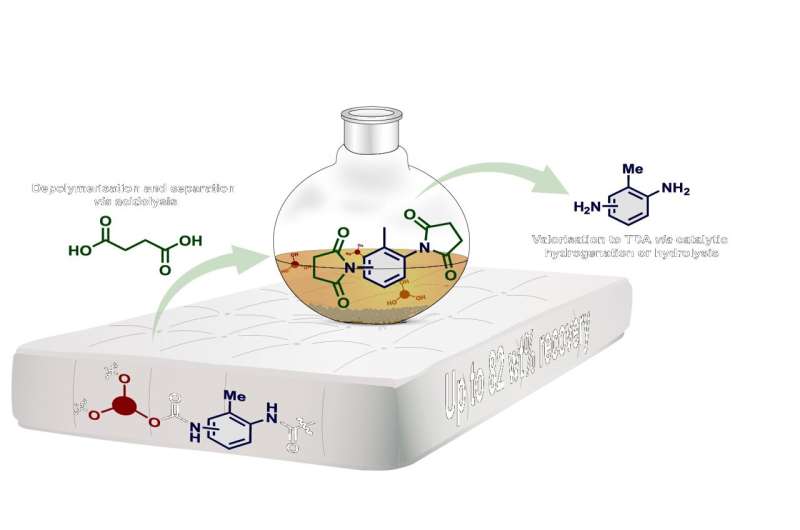
The graphic shows how the new combination of acidolysis and hydrolysis can recover up to 82 percent by weight of the original material from flexible PUR foam – used in mattresses – as two separate fractions of diamines and polyols. The diamine is represented as TDA (toluenediamine). Photo credit: Thomas Balle Bech, Aarhus University
Researchers at Aarhus University have found a better way to recycle polyurethane foam from products such as mattresses. This is great news for the emerging industry, which aims to chemically reclaim the material’s original components – and thus make its products cheaper and better.
Polyurethane (PUR) is an indispensable plastic used in mattresses, insulation in refrigerators and buildings, shoes, cars, airplanes, wind turbine blades, cables and much more. You could call it a miracle material if it weren’t also a burden on the environment and climate. Most of the PUR products thrown away around the world end up incinerated or in landfills.
This is problematic because the main components of the material are mainly obtained from fossil oil. And we are talking about significant quantities. In 2022, the global market for PUR reached almost 26 million tons, and a forecast for 2030 assumes just under 31.3 million tons, with around 60 percent of this being foam in various forms.
However, there is a small but growing industry that chemically breaks down (depolymerizes) PUR into its original main components, polyol and isocyanate, with the aim of reusing them as raw materials in new PUR products.
However, there is still a long way to go before their production can actually compete with “virgin” materials. Separating and purifying the desired elements is expensive.
Disassembly and separation in one operation
This is where a team of researchers from Aarhus University comes in with a clever idea. They base their method on what the companies in question are already using, namely the decomposition of PUR foam with acid (acidolysis).
However, the companies do not separate the decomposed PUR into polyol and isocyanate. This creates a mixture that cannot be recycled directly, but instead requires customers to create new recipes.
The AU researchers can not only break down PUR and separate the two main components – they can do it in one go. They heat flexible PUR foam with a little succinic acid in a reactor to 220°C (see info box). They then use a filter that catches one substance and lets the other through.
It is the polyols that get through, and in a quality comparable to new polyol, so that they can be used in the new production of polyurethane. The filtered-out solid part of the product mixture is converted in a simple hydrolysis process into a so-called diamine, which is used in the production of isocyanates and thus PUR.
In this way, the researchers manage to recover up to 82 percent by weight of the original material from flexible PUR foam – which is used in mattresses – as two separate fractions of diamines and polyols. The researchers recently published their results in the journal Green chemistry.
Enormous potential in the industry
“The method can be easily scaled up,” emphasizes one of the study’s authors, Steffan Kvist Kristensen, assistant professor at the Interdisciplinary Center for Nanoscience (iNANO) at Aarhus University.
He sees enormous potential for recycling PUR foam waste in factories that use it as raw material (block foam) in their production.
“However, the prospect of also processing PUR waste from consumers still requires further development,” he adds.
Each manufacturer in the PUR industry uses unique formulas to achieve certain material properties for their products.
Therefore, before real savings can be achieved in polyurethane recycling, a number of challenges must be overcome:
- Waste separation
- logistics
- Sort PUR by type
Depolymerization therefore represents only a small part of the solution.
AU researchers have also tested the combination of acidolysis and hydrolysis on regenerated PUR foam and PUR rigid foam. And it works. However, the path to a circular economy is even longer here.
PUR rigid foam is mainly used as an insulating material, but its conversion into valuable raw materials is still in its infancy.
Currently, the researchers are testing the new technology on other polyurethane materials to see how they can be recycled. They are also investigating how the dicarboxylic acid that is part of the process can be reused. In addition, they will test the recycled materials to create new products and show that the technology can indeed create a circular economy.
Further information:
Thomas B. Bech et al, Chemical separation of polyurethane by acidolysis – combination of acidolysis and hydrolysis for the upgrading of aromatic amines, Green Chemistry (2024). DOI: 10.1039/D4GC00819G
Provided by Aarhus University
Quote: Researchers discover smarter way to recycle polyurethane (August 16, 2024), accessed August 16, 2024 from https://phys.org/news/2024-08-smarter-recycle-polyurethane.html
This document is subject to copyright. Except for the purposes of private study or research, no part of it may be reproduced without written permission. The contents are for information purposes only.



